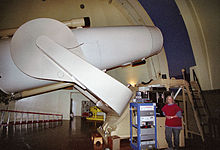- Samuel Oschin telescope
-
The Samuel Oschin telescope (also named Oschin Schmidt) is a 48-inch (1.22-m) aperture Schmidt camera at the Palomar Observatory in northern San Diego County, California. It consists of a 49.75-inch Schmidt corrector plate and a 72-inch (f/2.5) mirror. The instrument is strictly a camera; there is no provision for an eyepiece to look through it. It originally used 10 and 14-inch glass photographic plates. Since the focal plane is curved, these plates had to be preformed in a special jig before being loaded into the camera.
Construction on the Schmidt telescope began in 1939 and it was completed in 1948. It was named the Samuel Oschin telescope in 1986, before that it was just called the 48 inch Schmidt.[1]
The camera has been converted to use a CCD imager. This is a mosaic of 112 CCDs covering the whole (4 degree by 4 degree) field of view of the camera, the largest CCD mosaic used in an astronomical camera at this time. The corrector plate was recently replaced using glass that is transparent to a wider range of wavelengths. The camera was originally hand-guided through one of two 10-inch (25.5 cm) aperture refracting telescopes mounted on either side of the camera. The camera is now fully automated and remote-controlled. The data collected is transmitted over the High Performance Wireless Research and Education Network (HPWREN). It is programmed and operated primarily from Pasadena, California with no operator on-site (except to open and close the dome).
Contents
The plate archive
About half of the large photographic glass plate negatives exposed on the telescope, some 19,000 in all, had been accumulating in the sub-basement of the Robinson building at the California Institute of Technology since 1949. In 2002, astronomer Jean Mueller approached Richard Ellis, the director of the Caltech Optical Observatories, to volunteer to the task of organizing the Oschin Telescope plate archive. Given the go-ahead, she recruited eleven volunteers from the Mount Wilson Observatory Association (MWOA) and the Los Angeles Astronomical Society (LAAS), and the team then spent 13 weekends (more than one thousand hours) poring over the stacks, placing plates in protective sleeves, and packing them in more than 500 boxes that were transported to Palomar.
All of the volunteers were presented with the gift of having asteroids named after them, compliments of Carolyn S. Shoemaker: 10028 Bonus, 12680 Bogdanovich, 13914 Galegant, 16452 Goldfinger, 19173 Virginiaterése, 20007 Marybrown, 21148 Billramsey, 22294 Simmons, 27706 Strogen, and 29133 Vargas. Mueller was also rewarded by a visit to the Keck Observatory in Hawaii.
Discoveries
The Oschin Telescope was responsible for the discovery of 90377 Sedna on 2003-11-14 and Eris, the "10th Planet" on 2005-01-05 from images taken 2003-10-21. The peculiar Type Ia supernova SN 2002cx was discovered with the Oschin telescope on 2002 May 12.21 UT.[1] Other discoveries include 90482 Orcus (in 2004) and 50000 Quaoar (in 2002), both large trans-Neptune objects.
In June 2011 it was reported the telescope discovered 6 supernovae located 8 billion light years from Earth whose composition lacks hydrogen. This is different than normal supernovaes, and will contribute to the research of star formation.[2]
References
- ^ Wood-Vasey, W. M.; Aldering, G.; Nugent, P. (2002-05-17). "Circular No. 7902". Central Bureau for Astronomical Telegrams (Smithsonian Astrophysical Observatory, Cambridge, Massachusetts: International Astronomical Union). http://www.cbat.eps.harvard.edu/iauc/07900/07902.html. Retrieved 2011-07-05.
- ^ "Astronomers discover supernovae at Palomar", Mark Kenney. June 8, 2011. Accessed June 11, 2011
External links
- Information from the U.S. National Park Service
- Picture, c. 1960
- Edwin Hubble at the 48" Schmidt.
- Order comes to a plate-glass universe, Caltech336, Vol. 203, May 29, 2003
See also
Eris Discovery - Mike Brown
- Chad Trujillo
- David Rabinowitz
- Samuel Oschin telescope
- Mount Palomar Observatory

Moon Classification Other topics - Tenth planet
- Reflecting telescope
Categories:- Telescopes
- Eris
Wikimedia Foundation. 2010.

